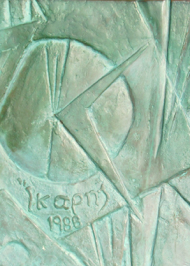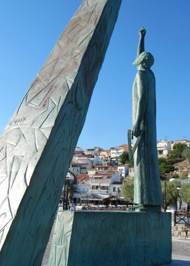pythagoras
FOUNDER OF MATHEMATICS
BORN ON THE ISLAND of SAMOS
the dodecanese, the Aegean Sea
Greece
C. 570 or 580-490 BC


pythagoras
FOUNDER OF MATHEMATICS
BORN ON THE ISLAND of SAMOS
the dodecanese, the Aegean Sea
Greece
C. 570 or 580-490 BC


The so-called Pythagoreans, who were the first to take up mathematics, not only advanced the subject, but saturated with it, they fancied that the principles of mathematics were the principles of all things.
-- Aristotle, Metaphysics 1-5, cc. 350 BC.
Pythagoras, born on the island of Samos in 580 BC, is the founder of mathematics. His most famous accomplishment is the Pythagorean Theorem” that is a geometrical axion about the right triangle. According to his proven theory a2 + b2 = c2 the square of the hypotenuse side equals the sum of the square of the other two vertical sides. It is said that Pythagoras was not only a geometrician, but also an astronomer and philosopher. He had a unique theoretical approach to music, which he combined with numbers. He also created an integral system of studying celestial bodies with mathematical and geometrical evidence. In his theories, philosophical and religious goals have unbreakable bonds and walk side by side. Moreover, his studies and theories have been based on numbers, measurements, and harmony. From an early age, he was well-respected by the Samian society, and by some accounts, he left Samos because he was over-burdened by his public duties because he was held in such high esteem. In Samos, however, Pythagoras is said to have left the island around 530 BC because of his “political contrast” with the island’s tyrannical ruler, Polykratis. He moved to Croton, in Italy, where he quickly attained extensive influence and many people began to follow him. His followers formed a secret brotherhood or club for the purpose of pursuing the religious or ascetic practices developed by their master. The exclusivity of the club made the local Crotons jealous and hostile, which led to their destruction. Enemies of the club roused the populace who set afire the building in which the assembled Pythagoreans were meeting. Only the young and agile members escaped. Similar scenarios happened in other cities in which Pythagorean societies had been formed. The Pythagorean order was suppressed, never to be revived. The sect continued to exist in secret, however, and the members continued their religious observances and scientific pursuits. In Samos, history claims that Pythagoras traveled and lived in Egypt, Babylon, Delos, at the Oracle of Delphi, and finally in southern Italy and Sicily. They also claim that he died an elderly man in Metopontum in southern Italy around 490 BC. There is quite a lot of myth surrounding the man and his followers; with some concern that he may have died in the fire of the assembled Pythagoreans. Whatever the case, Aristotle claimed that the philosophy of Plato closely followed the teachings of the Pythagoreans. This conclusion is based on the following four points regarding work of Plato:
•The platonic Republic might be related to the ideas of “a tightly organized community of like-minded thinkers, like the one established by Pythagoras in Croton.
•Plato probably took from Pythagoras the idea that mathematics and abstract thinking is a secure basis for philosophical thinking as well as for “substantial theses in science and morals”.
•Plato and Pythagoras shared a “mystical approach to the soul and its place in the material world”.
•Both Pythagoras and Plato were probably influenced by Orphism*
*NOTE: Orphism, traced back to the Ancient Greek and Hellenistic World c. 500-400 BC, is a set of religious beliefs and practices associated with the mythical poet Orpheus, who descended into Hades and returned. The practice of Orphism also revered Persephone, who descended into Hades for a season and returned, and Dionysus or Bacchus, who also descended into Hades and returned. Orpheus was said to have invented the Mysteries of Dionysus. Elements of Orphism include promised advantages in the afterlife.
PHOTOS: Top Three: 1. Depiction of Pythagoras (central figure) in an Italian Renaissance Painting. Detail: The Athens School, 1509, by Raffaello Sanzio (1483-1520) Fresco in the Stanza della Segnatura, Palazzi Pontifici, Vatican. 2. Sculpture honoring Pythagoas in Pythagorio,on the island of Samos, Greece. The figure representing the mathematician and philosopher is shown aligned with the catheti of a right triangle. Bottom Two: 1.The inscription on the marble base of the sculpture reads: Pythagoras of Samos 580-496 ΧΠ and the Greek abbreviation symbolizing BC, Before Christ. 2. Illustrations on the sculpture illustrating the Pythagorean theorem.

Mathematics as a Basis of the Universe



